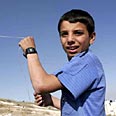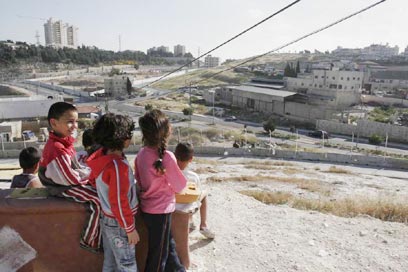
The Jerusalemites Israel doesn't like
East, west Jerusalem like two different cities; as nation marks 39 years to city’s reunification, discrimination is rampant. Arab residents lack schools, services, law enforcement
It is clear and unquestioned to every Israeli citizen that he gets his mail every day in his private mailbox. It is so natural and accustomed that no one even bothers to think what would happen if things were different. So here is a statistic: Some 75,000 people living in east Jerusalem’s Arab neighborhoods are served by a single postman.
“Even if he was superman he couldn’t deliver everyone’s mail. That’s why he leaves mail at the supermarket or store and people need to go and find their letters there, because in the northern neighborhoods people don’t have mailboxes,” head of the Beit Hanina community center Hussam Wataad says. “If for example someone is sent a water bill,” he says, “but he doesn’t get the letter, then the charges just get bigger and there isn’t much to do about it. The office says they sent it, the man says he didn’t get it. Something that is basic in the west of the city, like getting mail, in east Jerusalem is not so obvious.”
Mail delivery is just one small example, just a piece of the story. Officially, Israel marks 39 years to the reunification of its capital today, but Jerusalem was never really united. As the years go by, it appears unity between the two sides disintegrates more and more. The border that in the past separated Israel and Jordan still acts as a border, and on either side of Road 1 two almost completely separate cities exist, characterized by two very different lifestyles – both in the feeling on the street and in institutional relations.
If you are a resident of east Jerusalem, governmental or municipal dealings will be slow, deficient, suspicious – and always problematic. For the most part, east Jerusalem resident don’t try to object to the treatment they get compared to their western counterparts. They feel the border is not just physical but engraved in the heart of the everyday reality they live in. Wataad believes that the definition “helpless” is “a gentle way of describing the situation.” He prefers the term “an open wound in every aspect of life.”
There is no law here
Saman Khouri, an east Jerusalem resident and member of the Palestinian Coalition for Peace, is fed up with the situation around him. He claims that the reason the city is so segregated is rooted first and foremost in Israel’s treatment of east Jerusalem residents. “Since 1967, for example, there is almost no law enforcement in the east,” Khouri says.
“This allows crime, drugs and prostitution to get out of control, and no one cares – so everyone if his own judge and people don’t turn to the police. Under the Jordanian government there was very strong legal discipline in everything to do with moral crimes, but the Israeli Police don’t care about that. They are only concerned with crimes threatening the country’s security. There is the feeling that police aren’t here to protect us, the citizens, but to protect the country. Khouri claims that the negligible presence of police forces in east Jerusalem – compared to the massive presence of security forces and border police – “cause citizens to constantly feel they are on the wrong side of the border, not part of the city.”

Children in Shuafat (Photo: Haim Tzach)
The fact that east Jerusalem is a separate zone is evident in every aspect of daily life. Arab resident don’t ride Egged city buses. They have their own public transportation system which serves only the east side of the city. They have separate population registry bureaus, a branch of Bank Leumi, an employment bureau, and for every municipal service, they must wait long hours in line. Even in more critical instances, like life endangerment, the east Jerusalem resident must wait until a Magen David Adom ambulance arrives from the west – because they need to wait for police chaperones. In many cases, the ambulance arrives too late.
Electricity in east Jerusalem is supplied by a west Jerusalem electric company and not by the government. Water they get from the Al-Birah company, located in Ramallah. If a water pipe bursts, for example, staff is called in from Ramallah – but they aren’t always permitted entry into the Israeli area.
Budget for east Jerusalem? There is none
One doesn’t need to be a great expert on infrastructure to understand the Jerusalem municipality doesn’t budget much money to its Arab residents. It is enough to just walk through that part of town. The roads are studded with potholes, the few sidewalks are in total disrepair, and there are almost no public parks. In Zur-Bakhar, a neighborhood of 15,000, a sewage system has never been installed. In parts of Beit Hanina, Shuafat, Silwan, Jabel Mukaber and Ras al-Amud - the deal stinks: Residents of Kfar Akab, for example, were fed up with the sewage and decided on their own initiative to install a sewage system – and to finance it from their own pockets. They didn’t even ask the municipality if they could – what would be the point?
Building permits are also a rare item. To get one, residents must wait an average of five years if not longer. The bureaucratic foot-dragging is exhausting and pushes residents to often take the law into their own hands and – lacking any other option – violate it. And here is where the legal authorities suddenly lift their heads. The extent of building demolitions in the east side in unprecedented. According to data from the Committee against House Demolition in east Jerusalem, the number of demolition orders, both administrative and judicial, served by the city municipality in 2005 reached 937. Along with the demolition orders issued by the interior ministry, the figure climbs to 999.
One of the most painful problems is the poor condition of the education system. Yearly, hundreds of students are excluded from public schooling because of the shortage of classrooms. And the ones that do exist are overcrowded. In extreme cases, like at the a-Tur elementary school, there wasn’t enough room for all the students last year so classes were held in two shifts – from 8 a.m. to noon and from 12:30 p.m. to 4 p.m. The situation was repeated in Jabel Mukaber, Silwan and Kfar Akab. In 2002 the city adopted a plan to deal with the issue by building 1,155 classrooms by 2005. Despite the plan, only 276 classrooms have been built thus far – fewer than one quarter of those planned.
But maybe those crowding into the few classrooms should be thankful for their good luck. In 2004, according to statistics from the Central Bureau of Statistics, there were 79,000 school age students in east Jerusalem. But only 64,536 students were matriculated at private and public schools, according to the education ministry. From the disparity in the numbers it is unclear where – if at all – the remaining 14,500 students go to school. “Hundreds of children don’t go to school cause they have no schools to go to,” Wataad says. They simply sit at home or go to work or learn in the field. No one has the interest or courage to find where these children are or what they are doing.”
Demographic struggle
Yisrael Kimchi, head of research at the Jerusalem Institute for Israel Studies, says it is clear beyond any shadow of a doubt that there is discrimination between the east and west sides of the city. “There is a significant gap and it is evident in every service field. If its cleanliness, the lack of parks, classroom, street lighting, wherever – these gaps can be seen. It is clear that the State of Israel could have invested much more in the past 40 years, but didn’t.”

Overlooking Jerusalem (Photo: Haim Tzach)
But above all of these circumstances, floats the future, which has already started to gives its signals. In 1967 Jews accounted for 74 percent of Jerusalem’s population. In 2004 that number went down to 66 percent. Meanwhile, the number of Arab residents rose steadily. In 1967 Israeli Arabs accounted for 26 percent of the population, while in 2004 they made up 34 percent. From 1967-2003, Jerusalem’s population grew 160 percent. While the Jewish population in those years grew 135 percent, the Arab population increased 233 percent.
The demographic trend in Jerusalem is clear: Jewish population is decreasing compared to Arab population. Even Prime Minister Ehud Olmert, former mayor of Jerusalem, knows well the demographic balance of the city. In the past he spoke of the possibility that Israel would depart from a few tens of thousands of residents living in the city’s western rim. In a December 2003 interview with Yedioth Ahronoth, Olmert said, “I won’t go into detail about the border. I will just say that it will be based on maximizing the number of Jews and minimizing the number of Arabs within Israel. This way we can continue to run a democratic Jewish country. Since then the fence has been constructed around Jerusalem’s perimeter – and it excludes 55,000 Arab residents of east Jerusalem.
It is possible that by next Jerusalem Day, when Israel celebrates 40 years of the city’s reunification, everything will be different. Kimchi believes that “Jerusalem will look different – both the Israeli and Jordanian sides will look different. Israeli Jerusalem will be territorially expanded to include areas previously not part of the city’s municipal area, and Arab neighborhoods like Jabel Mukaber, Um-Zuba, Beit Hanina and Shuafat it seems will be cut off from the city.”










